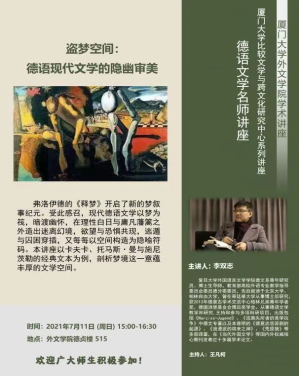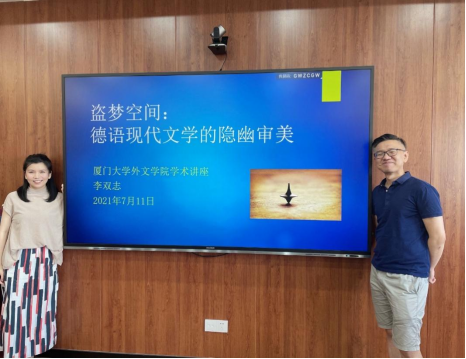on july 10, mr. li shuangzhi, a young researcher and doctoral supervisor of the german department at fudan university’s school of foreign languages and literatures and a member of the german sub-committee of the collegiate teaching steering committee for foreign languages under the ministry of education, gave a lecture on german literature at the xmu center for comparative literature and intercultural studies. titled “dream space – the hidden aesthetics of modern german literature”, the lecture was moderated by miss wang fanke, a german instructor in the cflc department of european languages. in the lecture, prof. li shuangzhi took dreams as a raft and expounded classic texts by kafka, thomas mann and schnitzler, revealing the dream world as a rich literary space.

prof. li began his lecture with an introduction of freud’s the interpretation of dreams, pointing out that the work opened up a new era of dream narratives. according to freud, interpretation of dreams is a congenial way to understand the unconscious in the mind. dreams are the fulfillment of repressed desires achieved in disguise, a repression hidden at the bottom of the mind marked by false forgetfulness that will reappear in the future in more terrible forms. according to freud, on the one hand, dreams are the manifestation of desire in reality; on the other hand, desire is presented in the form of disguise in dream, and the greater the repression, the more serious the disguise. under the control of the two forces of desire and repression, the dream world exhibits a strange and bright landscape.
huge social pressure faced by modern people forces them to suppress their desires and live a seemingly moderate life. as a result, the dream world becomes a space where desire and repression struggle with each other. prof. li shuangzhi stated that the dream world is a space that is isolated from reality but reflects the real world. the space of dreams has boundary and accessibility, and spatialized dreams are deformed symbols. according to freud’s theory, the spatial production of dreams can be summarized into three laws, namely, condensation, displacement and symbolism.

prof. li pointed out that freud’s dream interpretation theory not only opened the door to modern psychological research, but also provides an inexhaustible source of inspirations for literary creation. he noted that dreams are an indispensable element in modernist creation, and that the most important feature of modernism is its subtle and twisted way of expression. on the one hand, modern people live under a huge social machine and are forced to run like cogs; on the other hand, they face a crisis of personal subjectivity under the alienation of society. therefore, the life of modern people is marked by repression, and the dream world becomes a space for self-searching.
prof. li first took kafka’s ein traum as an example to explain the symbolic meaning of the dream space. the grave space appears in the dream of joseph card, the protagonist of the novel, and this space represents the repressed instinct to die. the grave bears a strong resemblance to the womb where life begins, a small, damp, dark space filled with no desire, no need, a void where everything is nil. the incomplete names on the tombstones reflect the aesthetics of delay, when the names are written in full, it is the time of death, which is also the time of awakening when dreams and reality overlap.
the second text expounded by prof. li is from schnitzler’s novel traumnovelle. the novel depicts a story about infidelity in the form of a dream narrative, embodying marriage, family, and the space of desire in the city. the spaces of lawn, city and forest in the heroine’s dream are rich in symbolic meaning, and the plot of the dream is also a reproduction of the real gender relationship in the dream through the law of displacement.

finally, prof. li used thomas mann’s famous novel der zauberberg as an example to further demonstrate the multiple spaces in the heterotopia. the story takes place in a sanatorium far away from the mundane world, and the main character has a fantasy dream during a heavy snowfall. in the dream, the warm and bright shore and naked men and women symbolize the primitive, eden-like natural world, and then the scene of the dream switches to a dark temple. all these changes symbolize the transition of mankind to the civilized world, and the ongoing sacrifices in the temple also suggest that civilization and barbarism go hand in hand. although civilization emerges from barbarism, barbarism and death do not dominate mankind. as the subsequent sentence in the text reveals, “man cannot let death be the master of his consciousness for the sake of goodness and love.” prof. li emphasized that the transition from punishment to redemption, from evil to goodness and from goodness to love, is the tradition of western literature as a whole.
prof. li’s lecture presented the audience with the psychedelic dream world beyond the barriers of reason and mediocrity, bringing a feast of modern german literature to cflc faculty and students.